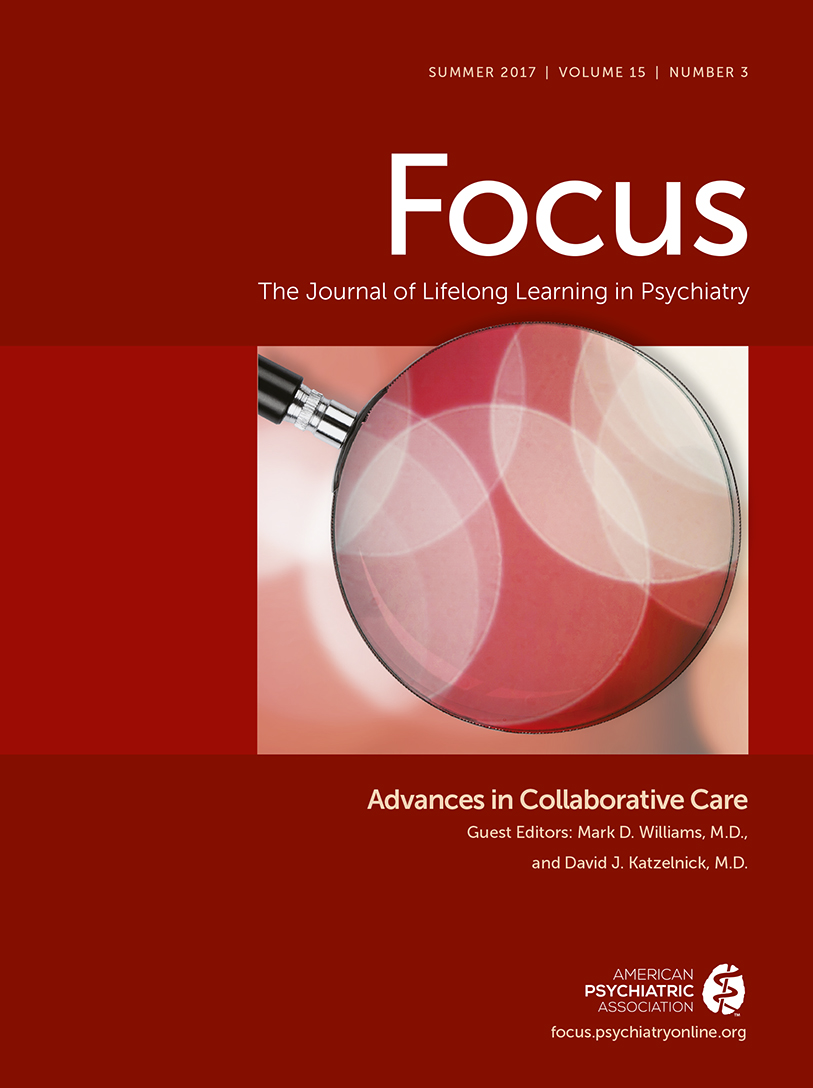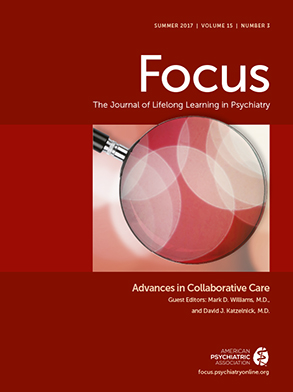Randomized Trial of an Integrated Behavioral Health Home: The Health Outcomes Management and Evaluation (HOME) Study
Druss BG, von Esenwein SA, Glick GE, et al.
Am J Psychiatry 2017; 174:246–255
OBJECTIVE: Behavioral health homes provide primary care health services to patients with serious mental illness treated in community mental health settings. The objective of this study was to compare quality and outcomes of care between an integrated behavioral health home and usual care. METHOD: The study was a randomized trial of a behavioral health home developed as a partnership between a community mental health center and a Federally Qualified Health Center. A total of 447 patients with a serious mental illness and one or more cardiometabolic risk factors were randomly assigned to either the behavioral health home or usual care for 12 months. Participants in the behavioral health home received integrated medical care on-site from a nurse practitioner and a full-time nurse care manager subcontracted through the health center.RESULTS: Compared with usual care, the behavioral health home was associated with significant improvements in quality of cardiometabolic care, concordance of treatment with the chronic care model, and use of preventive services. For most cardiometabolic and general medical outcomes, both groups demonstrated improvement, although there were no statistically significant differences between the two groups over time. CONCLUSIONS: The results suggest that it is possible, even under challenging real-world conditions, to improve quality of care for patients with serious mental illness and cardiovascular risk factors. Improving quality of medical care may be necessary, but not sufficient, to improve the full range of medical outcomes in this vulnerable population.
Reprinted with permission from American Psychiatric Association Publishing.
A Tipping Point for Measurement-Based Care
Fortney JC, Unützer J, Wrenn G, et al.
Psychiatr Serv 2017; 68:179–188
OBJECTIVE: Measurement-based care involves the systematic administration of symptom rating scales and use of the results to drive clinical decision making at the level of the individual patient. This literature review examined the theoretical and empirical support for measurement-based care. METHODS: Articles were identified through search strategies in PubMed and Google Scholar. Additional citations in the references of retrieved articles were identified, and experts assembled for a focus group conducted by the Kennedy Forum were consulted. RESULTS: Fifty-one relevant articles were reviewed. There are numerous brief structured symptom rating scales that have strong psychometric properties. Virtually all randomized controlled trials with frequent and timely feedback of patient-reported symptoms to the provider during the medication management and psychotherapy encounters significantly improved outcomes. Ineffective approaches included one-time screening, assessing symptoms infrequently, and feeding back outcomes to providers outside the context of the clinical encounter. In addition to the empirical evidence about efficacy, there is mounting evidence from large-scale pragmatic trials and clinical demonstration projects that measurement-based care is feasible to implement on a large scale and is highly acceptable to patients and providers. CONCLUSIONS: In addition to the primary gains of measurement-based care for individual patients, there are also potential secondary and tertiary gains to be made when individual patient data are aggregated. Specifically, aggregated symptom rating scale data can be used for professional development at the provider level and for quality improvement at the clinic level and to inform payers about the value of mental health services delivered at the health care system level.
Reprinted with permission from American Psychiatric Association Publishing.
The COMPASS Initiative: Description of a Nationwide Collaborative Approach to the Care of Patients with Depression and Diabetes and/or Cardiovascular Disease
Coleman KJ, Magnan S, Neely C, et al.
Gen Hosp Psychiatry 2017; 44:69–76
OBJECTIVE: To describe a national effort to disseminate and implement an evidence-based collaborative care management model for patients with both depression and poorly controlled diabetes and/or cardiovascular disease across multiple, real-world diverse clinical practice sites. METHODS: Goals for the initiative were as follows: (1) to improve depression symptoms in 40% of patients, (2) to improve diabetes and hypertension control rates by 20%, (3) to increase provider satisfaction by 20%, (4) to improve patient satisfaction with their care by 20% and (5) to demonstrate cost savings. A Care Management Tracking System was used for collecting clinical care information to create performance measures for quality improvement while also assessing the overall accomplishment of these goals. RESULTS: The Care of Mental, Physical and Substance-use Syndromes (COMPASS) initiative spread an evidence-based collaborative care model among 18 medical groups and 172 clinics in eight states. We describe the initiative's evidence-base and methods for others to replicate our work. CONCLUSIONS: The COMPASS initiative demonstrated that a diverse set of health care systems and other organizations can work together to rapidly implement an evidence-based care model for complex, hard-to-reach patients. We present this model as an example of how the time gap between research and practice can be reduced on a large scale.
Reprinted from General Hospital Psychiatry, copyright 2016, with permission from Elsevier.
The Role of the Integrated Care Psychiatrist in Community Settings: A Survey of Psychiatrists’ Perspectives
Norfleet KR, Ratzliff AD, Chan Y-F, et al.
Psychiatr Serv 2016; 67:346–349
OBJECTIVE: The objective of this study was to describe the work and experiences of psychiatrists practicing integrated care in the community. METHODS: Consulting psychiatrists working in integrated care participated in an online survey about their experiences, opinions, and advice. Results were analyzed with quantitative and qualitative methods. RESULTS: A convenience sample of 52 psychiatrists from around the country who were working in integrated care responded. Respondents reported that they address a wide variety of clinical problems with a range of treatment strategies. Most reported positive experiences, which were summarized in four themes: working in a patient-centered care model, working with a team, the psychiatrist's role as educator, and opportunities for growth and innovation. CONCLUSIONS: The survey documented the experiences of psychiatrists working in integrated care. Findings suggest that integrated care teams allow consulting psychiatrists to leverage their expertise to reach a large number of patients in a variety of practice settings.
Reprinted with permission from American Psychiatric Association Publishing.
Implementing Collaborative Care Programs for Psychiatric Disorders in Medical Settings: A Practical Guide
Beach SR, Walker J, Celano CM, et al.
Gen Hosp Psychiatry 2015; 37:522–527
OBJECTIVE: Collaborative care is a systematic, team-based approach to the management of depression and other psychiatric disorders in medical settings. Collaborative care has been found to be effective and cost-effective, but there is little information to guide its implementation in clinical care. The objective of this article is to provide a practical guide to the implementation of collaborative care programs in real-world settings. METHODS: Based on our experience delivering collaborative care programs, we provide (a) specific, stepwise recommendations for the successful implementation of collaborative care in outpatient settings and (b) an examination of the additional benefits and challenges of collaborative care programs that begin during hospitalization. RESULTS: The implementation of collaborative care requires senior buy-in, an effective team, clear treatment components, engaged clinicians, procedures to ensure quality and adequate infrastructure. Beginning these programs with hospitalized patients may offer additional advantages but also requires additional flexibility to adapt to the inpatient setting. CONCLUSION: A systematic approach to the development and implementation of collaborative care programs may allow clinicians to effectively and efficiently treat psychiatric illness in medical populations in both inpatient and outpatient settings.
Copyright 2015, Elsevier Inc. All rights reserved.
Reprinted from General Hospital Psychiatry, copyright 2015, with permission from Elsevier.
Essential Articles on Collaborative Care Models for the Treatment of Psychiatric Disorders in Medical Settings: A Publication by The Academy of Psychosomatic Medicine Research and Evidence-Based Practice Committee
Huffman JC, Niazi SK, Rundell JR, et al.
Psychosomatics 2014; 55:109–122
BACKGROUND: Collaborative care interventions for psychiatric disorders combine several components integrated into the medical setting: (1) systematic psychiatric assessment, (2) use of a nonphysician care manager to perform longitudinal symptom monitoring, treatment interventions, and care coordination, and (3) specialist-provided stepped-care recommendations. Collaborative care interventions have now been evaluated in a wide spectrum of care settings and offer great promise as a way of increasing quality of patient care, improving health of populations, and reducing health care costs. METHODS: A systematic search of PubMed/MEDLINE databases was performed for publications between January 1970 and May 2013 to identify articles describing collaborative care and related interventions. Identified articles were then evaluated independently by multiple reviewers for quality and importance; additional articles were identified by searching reference lists and through recommendations of senior content-matter experts. The articles considered to be both of high quality and most important were then placed into categories and annotated reviews performed. RESULTS: Over 600 articles were identified of which 67 were selected for annotated review. The results reported in these articles indicate that collaborative care interventions for psychiatric disorders have been consistently successful in improving key outcomes in both research and clinical intervention studies; cost analyses also suggest that this model is cost effective. CONCLUSIONS: Collaborative care models for psychiatric disorders are likely to serve an increasingly large role in health care given their effect on patient and population outcomes and their focus on integration of care.
Reprinted from Psychosomatics, copyright 2014, with permission from the Academy of Psychosomatic Medicine.
Integrated Collaborative Care for Comorbid Major Depression in Patients with Cancer (Smartoncology-2): A Multicentre Randomised Controlled Effectiveness Trial
Sharpe M, Walker J, Holm Hansen C, et al.
Lancet 2014; 384(9948):1099–1108
BACKGROUND: Medical conditions are often complicated by major depression, with consequent additional impairment of quality of life. We aimed to compare the effectiveness of an integrated treatment programme for major depression in patients with cancer (depression care for people with cancer) with usual care. METHODS: SMaRT Oncology-2 is a parallel-group, multicentre, randomised controlled effectiveness trial. We enrolled outpatients with major depression from three cancer centres and their associated clinics in Scotland, UK. Participants were randomly assigned in a 1:1 ratio to the depression care for people with cancer intervention or usual care, with stratification (by trial centre) and minimisation (by age, primary cancer, and sex) with allocation concealment. Depression care for people with cancer is a manualised, multicomponent collaborative care treatment that is delivered systematically by a team of cancer nurses and psychiatrists in collaboration with primary care physicians. Usual care is provided by primary care physicians. Outcome data were collected up until 48 weeks. The primary outcome was treatment response (≥50% reduction in Symptom Checklist Depression Scale [SCL-20] score, range 0-4) at 24 weeks. Trial statisticians and data collection staff were masked to treatment allocation, but participants could not be masked to the allocations. Analyses were by intention to treat. This trial is registered with Current Controlled Trials, number ISRCTN40568538. FINDINGS: 500 participants were enrolled between May 12, 2008, and May 13, 2011; 253 were randomly allocated to depression care for people with cancer and 247 to usual care. 143 (62%) of 231 participants in the depression care for people with cancer group and 40 (17%) of 231 in the usual care group responded to treatment: absolute difference 45% (95% CI 37-53), adjusted odds ratio 8·5 (95% CI 5·5-13·4), p<0·0001. Compared with patients in the usual care group, participants allocated to the depression care for people with cancer programme also had less depression, anxiety, pain, and fatigue; and better functioning, health, quality of life, and perceived quality of depression care at all timepoints (all p<0·05). During the study, 34 cancer-related deaths occurred (19 in the depression care for people with cancer group, 15 in the usual care group), one patient in the depression care for people with cancer group was admitted to a psychiatric ward, and one patient in this group attempted suicide. None of these events were judged to be related to the trial treatments or procedures. INTERPRETATION: Our findings suggest that depression care for people with cancer is an effective treatment for major depression in patients with cancer. It offers a model for the treatment of depression comorbid with other medical conditions.
Reprinted from The Lancet, copyright 2014, with permission from Elsevier.

